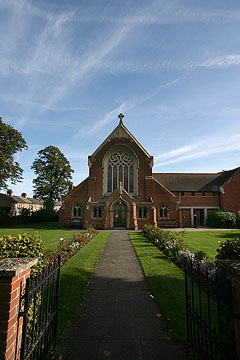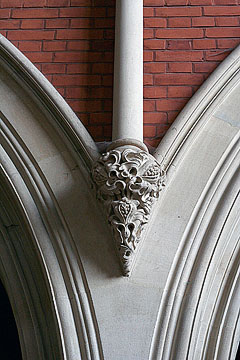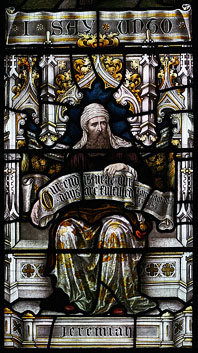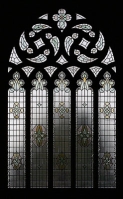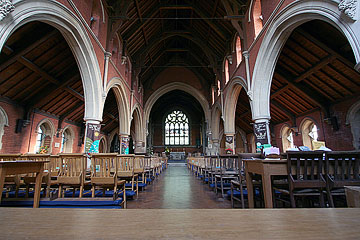St John dates from 1896, and was built during the late Victorian expansion into the countryside south of Cambridge. It sits on Hills Road, past the railway bridge and opposite Homerton College (which is now part of the University of Cambridge, but has had a long and glorious history as an important centre for religious dissent and teacher training).
The road widens here into a fine tree-lined boulevard, and everything becomes very civilised and suburban until you reach the concrete jungle of Addenbroke's Hospital about half a mile to the south.
 |
As you might expect, St John therefore has a comfortable, expansive feel to it. It sits a way back from the road, in a large green churchyard surrounded by a low beech hedge.
It's a fine building. The Victorian portion is a red brick aisled hall, with some details picked out in white stone.There is no tower, and the architects made full use of the tall west face, which is dominated by a very fine window of five lights topped by swirling quatrefoil tracery.
Above the window the apex is picked out in stonework, and below it is a low porch with an ogeed arch over the central doorway and a statue of the patron gazing down the path. The two aisles terminate in less elaborate windows in Decorated style.
Entry to the church itself is no longer through that west door, though, since (as a relatively rare indication of continuing prosperity on the part of the parish) there is a new complex of parish buildings on the south side, providing a new porch, parish room and so on. They're very sensitively done, incidentally - built in modern brick, and much plainer than the church itself, but echoing the style of the latter successfully.
We visited just after a Sunday service in the autumn, while the congregation were leaving and the vicar was chatting to people. Mark fell into conversation with him, while I went to explore the building. It's sometimes hard to disentangle the overall impression one gets of the architecture of a church - which often comes to little more than 'approve' or 'disapprove' - from any warm or chilly feelings engendered by the welcome one receives, and we received a very warm welcome here, from the priest and from the stalwarts of the congregation.
Even if we'd visited when it was empty, though, I would have been impressed: this is Victorian work at its best.
The nave arcades are broad, with round pillars and several layers of moulding folded into the arches. Triangular brackets, elaborately carved with foliage, support little pillars which run up between the clerestory windows and support the wooden roof. Like the exterior, the interior is mostly built in red brick, with highlights picked out in which stone.
The chancel arch springs from engaged granite pillars supported on brackets in the same style as the ones in the nave. They are, however, much bigger and grander: in addition to vine leaves, there are deeply undercut strawberry leaves, ears of corn and so on. The quality of the carving is wonderful: very sharp, and very exuberant. As it happened, we had visited shortly after their harvest festival, so the plenty represented in the carvings was matched by a display of fruit, vegetables and grain on the windowsills in the aisles.
There's similar carving in a band at dado height around the east end, running underneath the east window. This matches its western counterpart in elaboration, though it has trefoils rather than quatrefoils in the tracery above the main lights. The main image in the glass is an uninspired Last Supper, but the top is filled with a host of angels flitting elegantly around the complicated loops and swirls of stonework.
All in all, it's a fine building. I concluded my note-taking, tried to work out whether I liked the pulpit with its polychromatic marble, and returned to join the vicar at the west end. As I arrived, he was telling Mark about a member of the congregation who is 102. She can remember the people who built the church, which would have been seven years old when she was born. When one measures time by lifetimes, human history suddenly seems to speed up; all that's needed is one link, living and breathing, to connect us with a very different world.
St John the Evangelist was open when we visited;
I don't know if it is kept
open as a matter of course.
